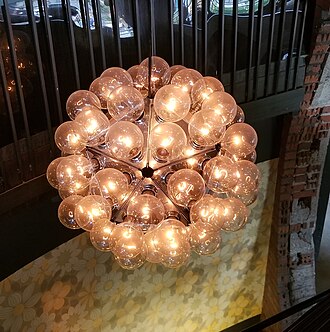Incandescent light bulb





Incandescent light bulb refers to a source of electric light that works by incandescence, which is the emission of light caused by heating the filament. When electrical current passes through a thin filament, typically made of tungsten, the filament heats up to a temperature where it glows, thus producing light. The enclosing glass bulb contains either a vacuum or an inert gas to prevent the filament from oxidizing and breaking.
History[edit]
The development of the incandescent bulb is often attributed to Thomas Edison, who created a commercially viable bulb in 1879 that could last up to 1200 hours. However, the invention of the incandescent bulb cannot be credited to a single inventor. It was the result of the work of many individuals, including Humphry Davy, who demonstrated the first electric lamp in 1802, and Joseph Swan, who independently developed a working bulb around the same time as Edison. The collaboration and competition between Edison and Swan led to the creation of the Edison and Swan Electric Light Company, which began the widespread adoption and commercialization of incandescent bulbs.
Design and Function[edit]
An incandescent bulb is made up of a glass enclosure containing a tungsten filament. The base of the bulb connects to an electrical supply, and when the bulb is turned on, electricity flows through the filament. The filament's resistance to the electric current causes it to heat up and emit light. The glass enclosure prevents the hot filament from coming in contact with oxygen, which would cause it to burn out quickly. Early bulbs used a vacuum, but modern bulbs often use an inert gas like argon to increase efficiency and bulb life.
Types and Uses[edit]
Incandescent bulbs come in various shapes, sizes, and wattages, ranging from small indicator lights to large, high-wattage bulbs used in commercial lighting. They are widely used in residential applications for their warm light and ability to render colors accurately. However, due to their low energy efficiency compared to LED lights and compact fluorescent lamps (CFLs), their use has declined in recent years. Many countries have implemented regulations to phase out incandescent bulbs in favor of more energy-efficient lighting solutions.
Environmental Impact[edit]
The major drawback of incandescent bulbs is their low energy efficiency. Only about 5% of the energy used by an incandescent bulb is converted into visible light, while the rest is lost as heat. This inefficiency contributes to higher electricity consumption and, consequently, higher greenhouse gas emissions. The move towards more energy-efficient lighting technologies is part of global efforts to reduce energy consumption and combat climate change.
Regulations and Phase-Out[edit]
In response to the environmental impact and the need to conserve energy, many countries have enacted regulations to phase out the use of incandescent bulbs. These regulations typically involve setting minimum efficiency standards that effectively ban the manufacture, importation, or sale of traditional incandescent bulbs. The transition to more efficient lighting technologies, such as LEDs and CFLs, is encouraged through these regulations, leading to significant reductions in energy consumption and greenhouse gas emissions.
Conclusion[edit]
While the incandescent light bulb was a cornerstone of modern development, lighting the way for over a century, its time is coming to an end due to its inefficiency and environmental impact. The legacy of the incandescent bulb is one of innovation and progress, but the future of lighting lies in technologies that offer greater energy efficiency and sustainability.
Ad. Transform your life with W8MD's Budget GLP-1 injections from $75


W8MD offers a medical weight loss program to lose weight in Philadelphia. Our physician-supervised medical weight loss provides:
- Weight loss injections in NYC (generic and brand names):
- Zepbound / Mounjaro, Wegovy / Ozempic, Saxenda
- Most insurances accepted or discounted self-pay rates. We will obtain insurance prior authorizations if needed.
- Generic GLP1 weight loss injections from $75 for the starting dose.
- Also offer prescription weight loss medications including Phentermine, Qsymia, Diethylpropion, Contrave etc.
NYC weight loss doctor appointmentsNYC weight loss doctor appointments
Start your NYC weight loss journey today at our NYC medical weight loss and Philadelphia medical weight loss clinics.
- Call 718-946-5500 to lose weight in NYC or for medical weight loss in Philadelphia 215-676-2334.
- Tags:NYC medical weight loss, Philadelphia lose weight Zepbound NYC, Budget GLP1 weight loss injections, Wegovy Philadelphia, Wegovy NYC, Philadelphia medical weight loss, Brookly weight loss and Wegovy NYC
|
WikiMD's Wellness Encyclopedia |
| Let Food Be Thy Medicine Medicine Thy Food - Hippocrates |
Medical Disclaimer: WikiMD is not a substitute for professional medical advice. The information on WikiMD is provided as an information resource only, may be incorrect, outdated or misleading, and is not to be used or relied on for any diagnostic or treatment purposes. Please consult your health care provider before making any healthcare decisions or for guidance about a specific medical condition. WikiMD expressly disclaims responsibility, and shall have no liability, for any damages, loss, injury, or liability whatsoever suffered as a result of your reliance on the information contained in this site. By visiting this site you agree to the foregoing terms and conditions, which may from time to time be changed or supplemented by WikiMD. If you do not agree to the foregoing terms and conditions, you should not enter or use this site. See full disclaimer.
Credits:Most images are courtesy of Wikimedia commons, and templates, categories Wikipedia, licensed under CC BY SA or similar.
Translate this page: - East Asian
中文,
日本,
한국어,
South Asian
हिन्दी,
தமிழ்,
తెలుగు,
Urdu,
ಕನ್ನಡ,
Southeast Asian
Indonesian,
Vietnamese,
Thai,
မြန်မာဘာသာ,
বাংলা
European
español,
Deutsch,
français,
Greek,
português do Brasil,
polski,
română,
русский,
Nederlands,
norsk,
svenska,
suomi,
Italian
Middle Eastern & African
عربى,
Turkish,
Persian,
Hebrew,
Afrikaans,
isiZulu,
Kiswahili,
Other
Bulgarian,
Hungarian,
Czech,
Swedish,
മലയാളം,
मराठी,
ਪੰਜਾਬੀ,
ગુજરાતી,
Portuguese,
Ukrainian


